Some propose that more nuclear power plants be built for generating electric power. This has been done on a large scale in France (about 75% of electric power in 2005), although the United States obtains more power from uranium than does France.
The electric power generated could be used to charge energy storage devices in vehicles for transportation.
The graph below shows the uranium extraction data for the World and a Verhulst function fit to the data in order to extrapolate into the future. The total amount to be eventually extracted used for the fit is 15,000x103 tonnes (1 tonne = 1000 kg), which is about 3,000x103 tonnes more than the known and estimated undiscovered uranium resources (6,260x103 tonnes) plus the amount already extracted (5,691x103 tonnes) (total of 11,951x103 tonnes).
However, it has been shown (Nuclear Power: The Energy Balance and Uranium Resources and Nuclear Energy) convincingly that uranium ores of low uranium concentrations will not produce net energy. Using the ore reserves for only concentrations greater than 0.05% mass-%U3O8 and adding a little to be optimistic, the graph below shows three fits to the uranium extraction data.
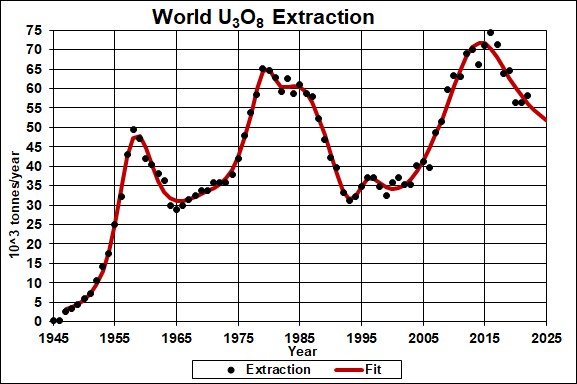
Uranium extraction rate for the World and Verhulst function fits to the data.
The red curve is the best fit to the data; it has an eventual extraction amount of 3,967x103 tonnes.
Note that the two big pushes (1955-1965 in the United States and Western Europe and 1975-1990 in Eastern Europe) to extract uranium during the Cold War, most of which went into building huge amounts of nuclear weapons by the United States and the Soviet Union. There is a program of the United States and Russia, called the “Megatons to Megawatts Program”, for converting high-enriched uranium used in weapons into low-enriched uranium to be used for electric power.
The graph below shows the extrapolation of the fits to year 2300.
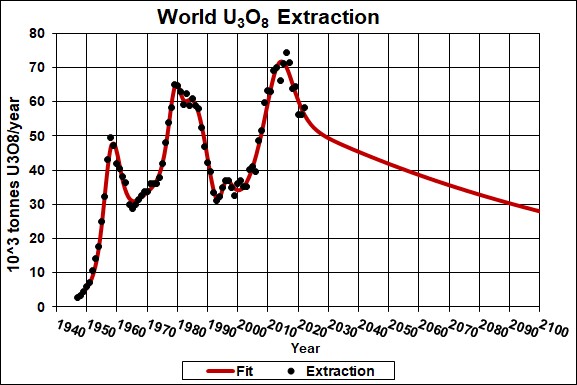
Uranium extraction rate for the World and Verhulst function fits to the data and their extrapolations into the future.
I expect that there will be a large peak in uranium extraction in the next few decades as crude oil and natural gas extraction decline, followed by a possible sharp dip after a major nuclear-reactor accident or terrorism involving a nuclear reactor, and then a rise again to then follow the declining curve of uranium depletion.
The four major extractors of uranium are Canada, Australia, Commonwealth of Independent States (11 states of the former Soviet Union) and the United States.
The recent rising demand for uranium is indicated by the recent fast rise in the price of uranium oxide as shown in the graph below. The price on 30 January 2006 was $37.50. Price per pound is expected to reach $50 per pound in the near future.
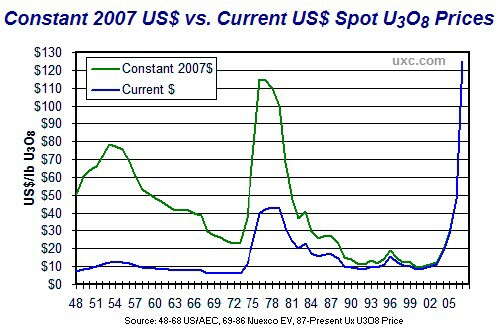
Spot prices per pound for U3O8. Note the Cold War prices peak and the 1970's energy-crisis peak.
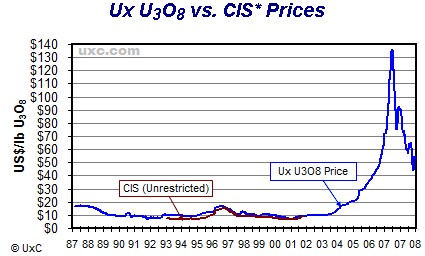
Spot prices per pound for U3O8 1987-2008.
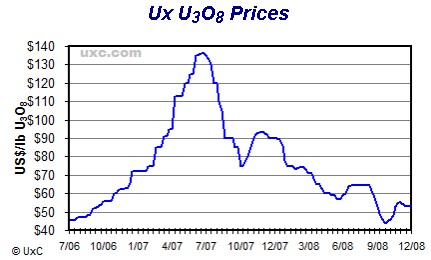
Spot prices per pound for U3O8 2006-2008.
One can see why the uranium price has been rising at a fast rate by comparing the extraction rate to the usage rate in the Western World, as shown in the graph below.
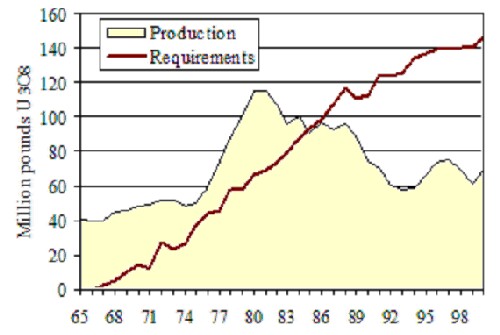
Western World uranium supply versus demand.
The environmental situation for use of uranium as an energy source is very problematical:
- Safe storage of radioactive waste for tens of thousands of years is required, which is well into the next Major Ice Age. It is a major problem. (Deep Time: How Humanity Communicates Across Millennia, Gregory Benford, Perennial, 2000.)
- Use of uranium for weapons of mass destruction, for radioactive terrorism, as armor for military weapons and in the tips of warheads of standard weapons are major problems. Uranium-tipped weapons were used extensively in the Gulf War, Bosnia War, Kosovo War and Bush Iraq War by the United States armed forces. See The Trojan Horses of Nuclear War, NEIS, 2003. Also, see http://arts.bev.net/roperldavid/politics/WeaponsRadioactive.htm for descriptions of the inhumanity of such weapons.
Benford relates the history and details of attempts to design warning systems for humans up to 10,000 years from now regarding underground storage sites for radioactive nuclear wastes. It is interesting that this time period is about the time to the first minimum of the next Major Ice Age. Perhaps humans will dig up the radioactive wastes to try to use them to keep warm or for religious rites. Read about how an event similar to the latter happened in Brazil: http://arts.bev.net/roperldavid/GRI.htm .
For more positive views of nuclear power see http://en.wikipedia.org/wiki/Nuclear_power and World Nuclear Association.
For negative views of nuclear power including a net energy analysis, see Nuclear Power: The Energy Balance, Uranium Resources and Nuclear Energy, Nuclear Power is Not the Answer by Helen Caldicott and The Nuclear Illusion by Amory B. Lovins and Imran Sheikh.
Energy from Uranium
An interesting question to ask is how much primary energy is supplied by "burning" uranium in nuclear reactors? The best analysis of energy produced by nuclear reactors I have found gives the following constants needed to do this calculation:
- The fraction of natural uranium in U3O8 ore is 0.846.
- The amount of electrical energy delivered by nuclear reactors is about 151.8 Tjoules/tonne of natural uranium = 144 109MBtu/tonne.
- The factor to convert electrical energy into thermal energy for nuclear reactors is about 2.6, which corresponds to a conversion efficiency of 1/2.6 = 0.38.
The amount of nuclear thermal energy produced by reactors as a function of time, assuming a very optimistic amount of nuclear resources, is shown in the following graph:
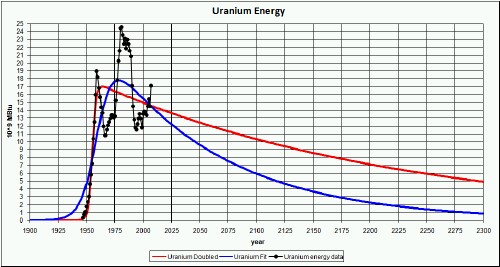
The red curve is a fit where the amount to eventually be extracted is double the amount of the blue curve, an extremely optimistic case.
It was assumed that all uranium mined is eventually used to extract energy. Of course, much of it was used and will be used to make nuclear weapons; however, some weapons were dismantled and their uranium used to extract energy. So this calculation is extremely optimistic for useful electrical energy that can be gotten from uranium.
The graph below compares the world energy consumption to the total energy supplied by the fossil fuels and uranium:

Doubling the total uranium finally extracted has very little effect. The conclusion is that uranium will never supply very much energy for humans to use.
The amount of energy that must be supplied by sources other than fossil fuels and uranium are shown in the graph below:
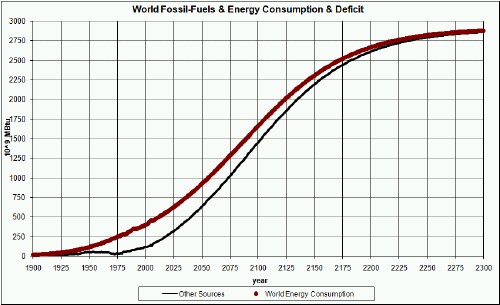
Breeder Reactors
Some claim that using breeder reactors instead of normal nuclear reactors will help solve the problem of fossil-fuels depletion. The claim is that breeder reactors will allow almost all of the uranium to yield energy instead of only about 1% as is the case for normal nuclear reactors. If that were true the uranium energy curve would be multiplied by about 100 in the graphs above.
Since breeder reactors are much more complicated than normal nuclear reactors and very little energy will be produced by normal nuclear reactors, the eventual amount of increase in nuclear energy for breeder reactors is probably far less that 100 times what will be produced by normal nuclear reactors. So, I would guess that the amount will be about 10 times what will be produced by normal nuclear reactors. That is, instead of nuclear energy from uranium fuel peaking at about 18x109 MBTU/year it would probably peak at about 180x109 MBTU/year, if indeed breeder reactors ever work out on a large scale. This is about the size of each of the fossil-fuels energy contribution and peaking at about the same time as or somewhat later than fossil fuels peak. That is, uranium fuel is not the salvation from fossil-fuels peaking.
Thorium Nuclear Fuel
Some claim that thorium will greatly increase the amount of nuclear energy available for human use, since thorium is three to five times more abundant in the Earth crust than is uranium. Bombarding thorium with slow neutrons converts it into uranium 233, which is fissionable similar to uranium 235.
Thorium nuclear reactors are more complicated than are uranium reactors. So, I would guess that the amount of energy available for use by humans from thorium fuel will never be as large as that available from uranium fuel.
I have done a depletion analysis of thorium.
Conclusion
It is possible that the decline in extraction of fossil fuels will cause a population collapse. This would surely cause the world energy consumption to also fall to some new asymptote. In that case the amount of energy that must be supplied by other than fossil fuels and uranium would be less than shown above.





.jpg)


















.bmp)
























































.jpg)

